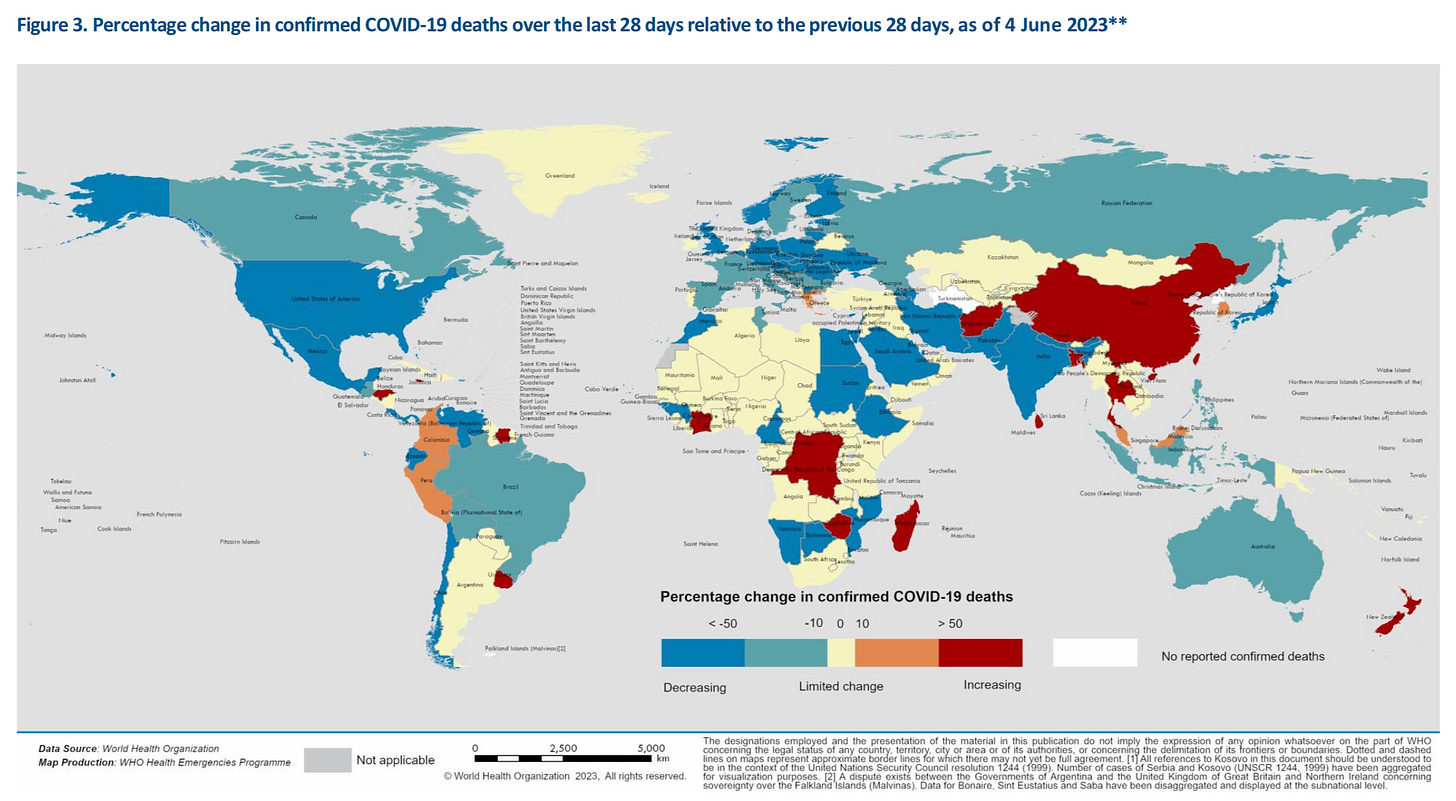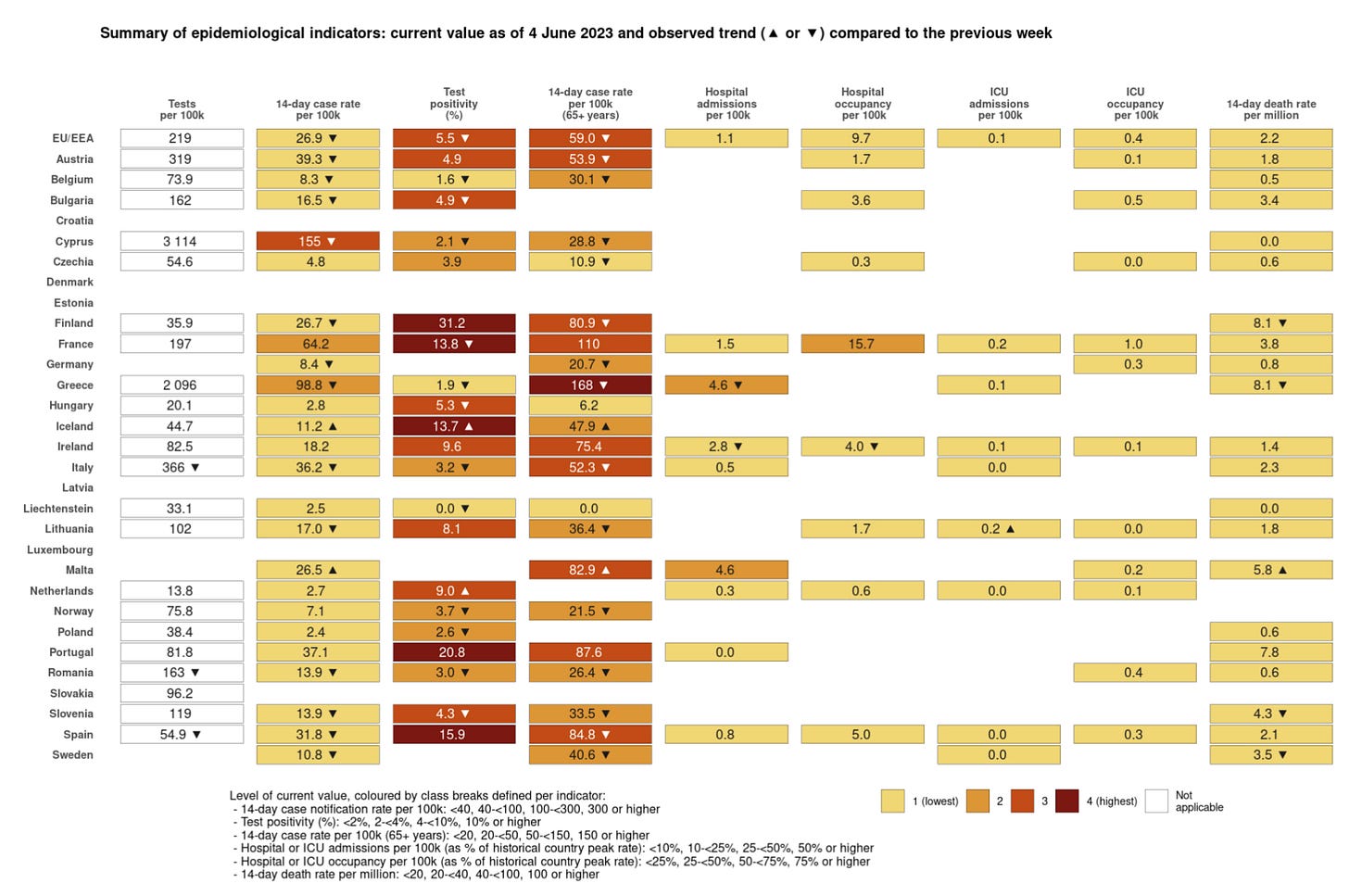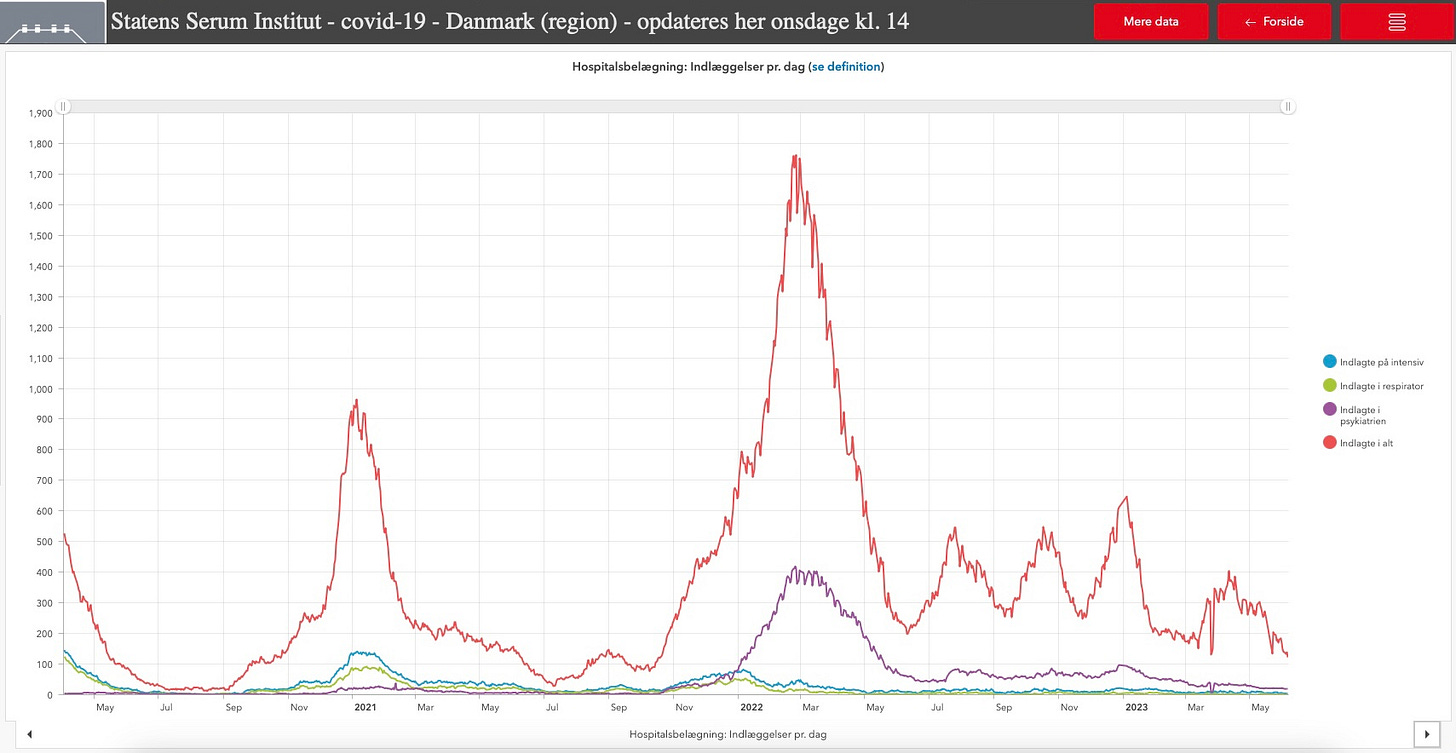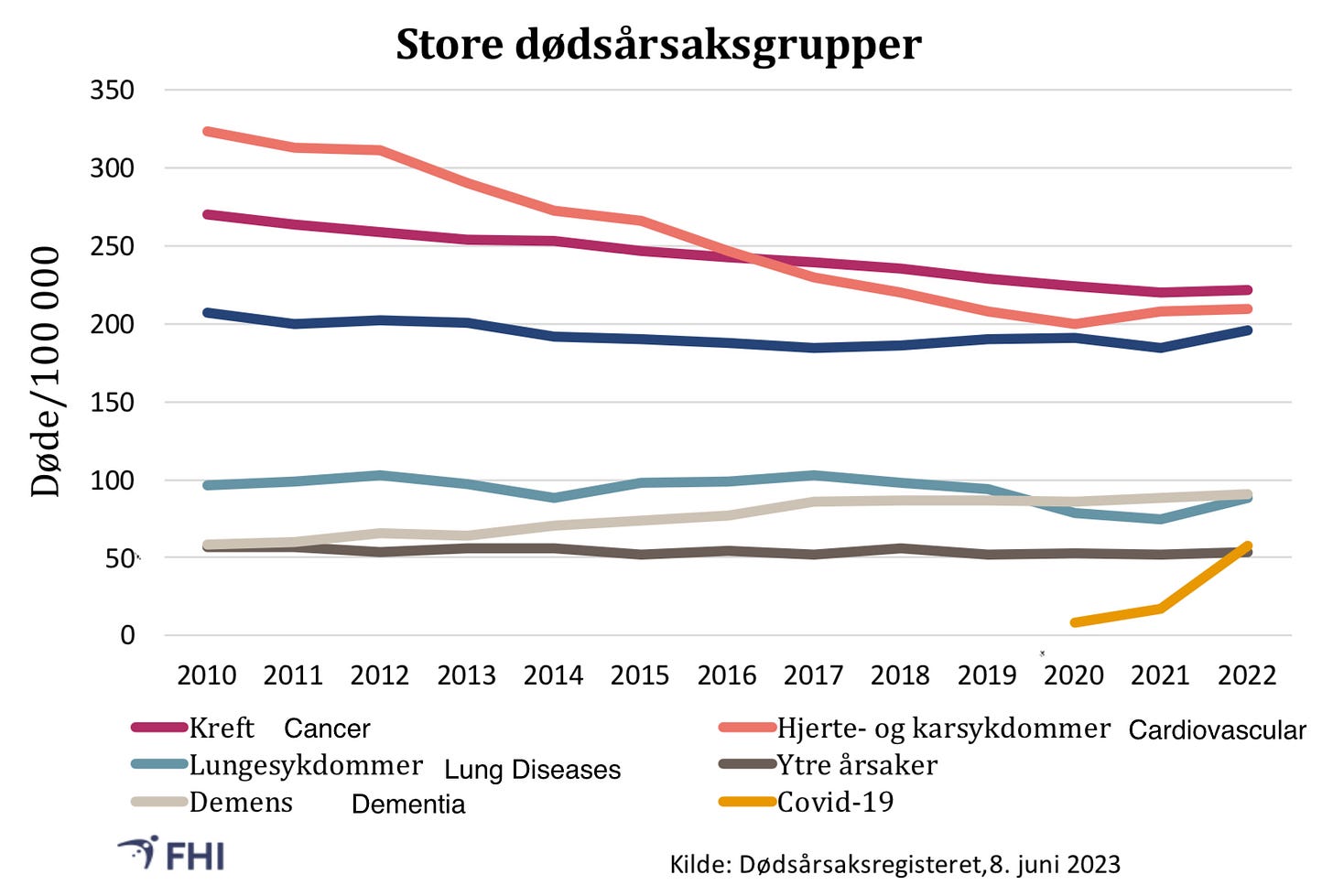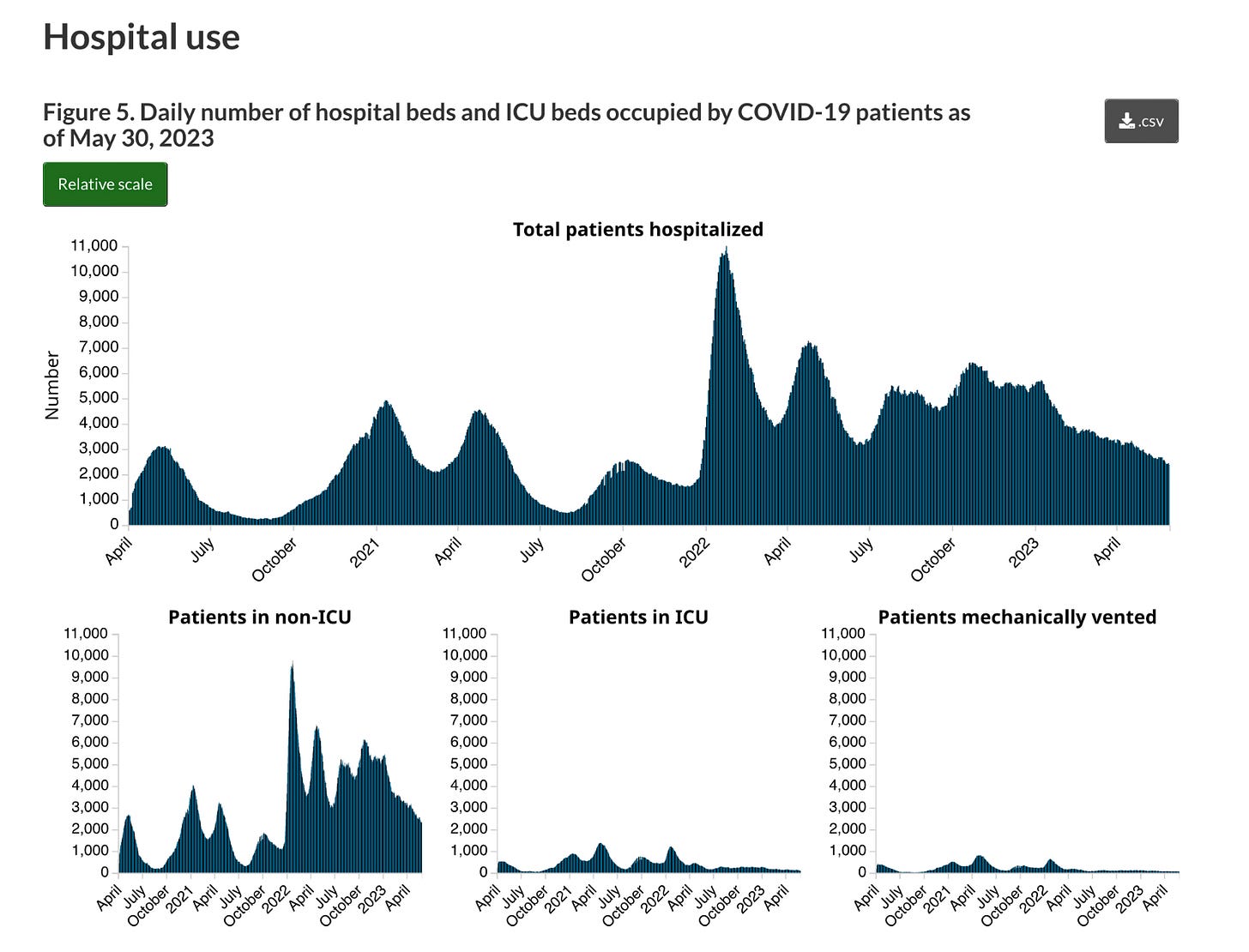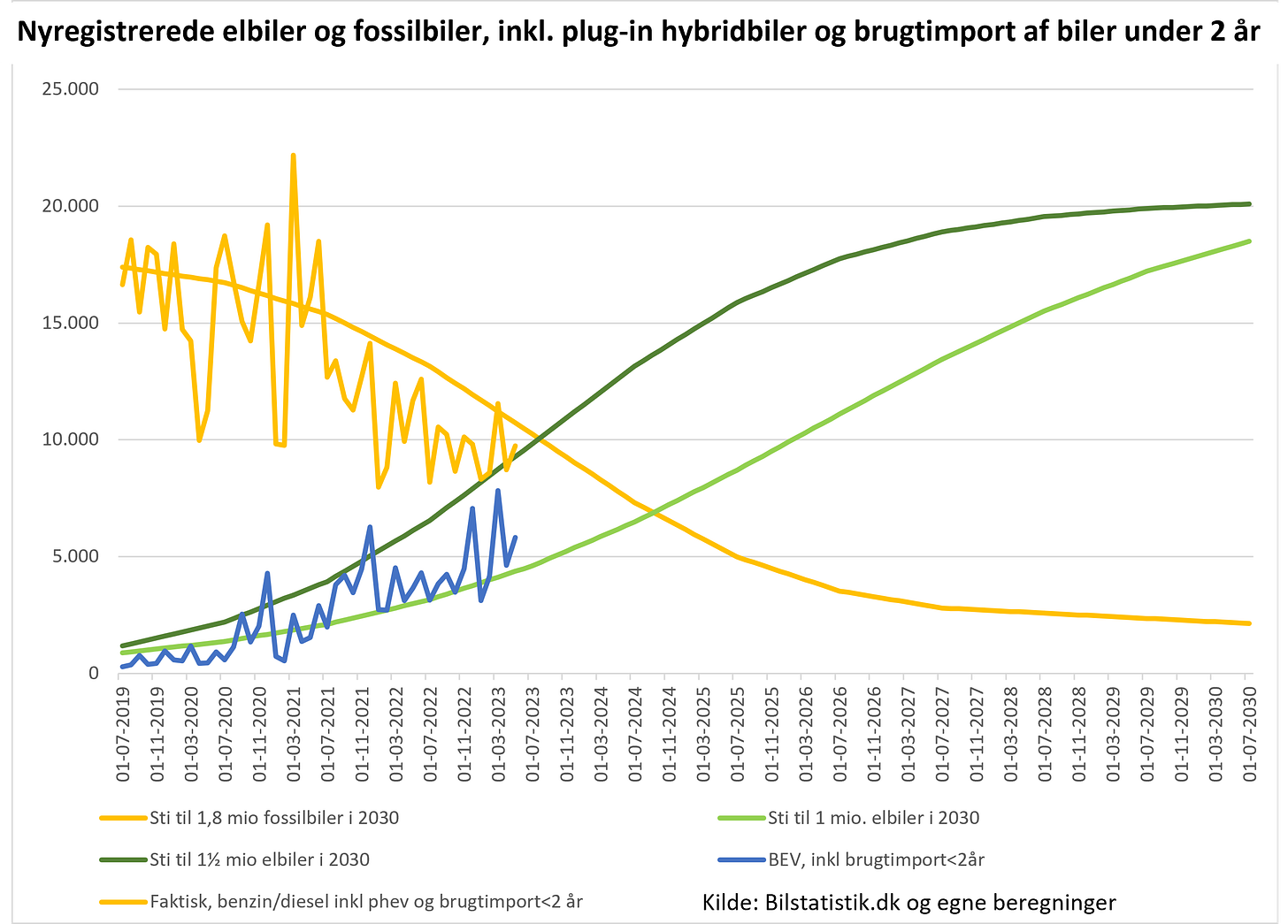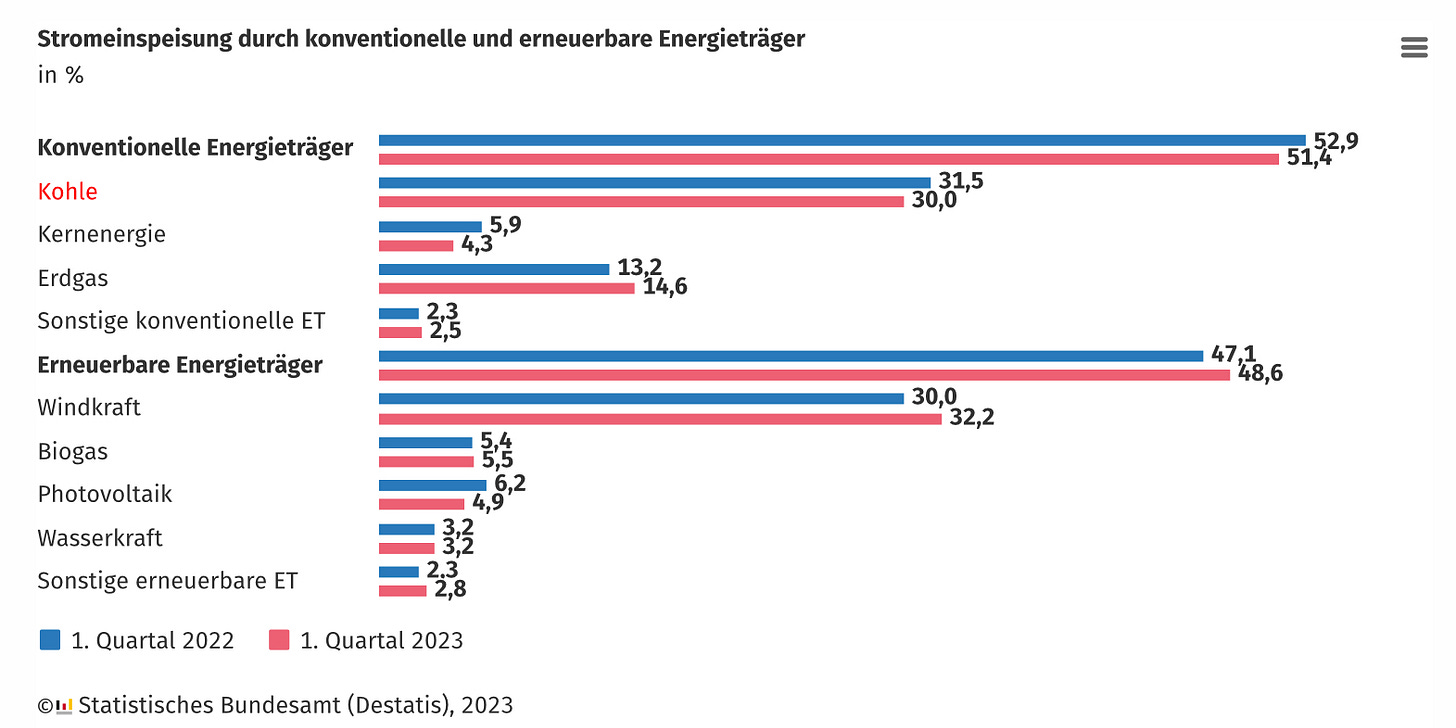🦠Pandemic🦠
🌍 🦠
“Our work is not done. While the emergency of COVID is over, COVID itself is not.”
It has been just over a month since the World Health Organization ended the public health emergency declaration for COVID. While the world tries to move on tuning out coronavirus developments, the WHO continues to plead for governments and health agencies to do the exact opposite.
Infectious Disease Epidemiologist, and WHO COVID Technical Lead, Maria Van Kerkhove says while most of the Western world can live in relative safety with access to health care, medicine, and some level of protection against severe infection, hospitalization, and death, that is not the case everywhere in the world.
“Our job is to inform all and support governments in maintaining the necessary life-saving actions, to use our blood, sweat and tears that resulted in substantial gains in surveillance, clinical care, development and access to countermeasures, address underlying inequalities, access, affordability to life-saving tools, continued research and development, there is still so much more work to do. Getting this message right is very difficult but it’s critically important. I know you don’t want to hear about COVID, but it’s our responsibility to inform you about current risks and what you can do, and what governments should do, to keep you safe. The virus is still circulating in every country, it’s evolving and while it’s not having the same impact it once had in terms of severe disease, it is causing long-COVID and far too many deaths.”
Kerkhove says governments shouldn’t be moving on and the WHO certainly isn’t.
“We can, collectively, do more to prevent this from happening with the right clinical care and access to medicines for all patients, targeted vaccination boosting in at-risk populations in all countries, and improved ventilation.”
While more and more countries abandon testing and genome sequencing, she is continuing to urge them to keep those systems in place. Kerkhove says only by maintaining surveillance and seeing the evolution of new and emerging variants can there be an agile healthcare response.
-
COVID numbers continue to plunge globally according to the latest weekly update from the World Health Organization. In a 28-day period ending June 4, there were over 1.7 million new infections (-38%) around the world while over 10,000 more lives were lost (-47%).
There was 79,266 new infection-related hospitalizations around the globe (-35%) and 1,937 intensive care admissions (-42%).
Infection numbers and virus deaths decreased in all six global health regions. But there were variations among the individual countries.
“Reported COVID cases are underestimates of infection rates, largely due to the reductions in testing globally and potential delays in reporting.”
Among the mere 17 countries reporting hospital data, five reported increases of 20% or greater. They are Mongolia with 1,968 new admissions (+1,582%), Zimbabwe (+133%), Afghanistan (+99%), Bangladesh (+68%), and Indonesia (+24%). Overall, the United States again registered the most new hospitalizations (35,037) of any country on Earth even though admission numbers in the country are falling (-29%).
Just nine countries are reporting intensive care numbers. Of those, only one reported an admissions increase of more than 20%. It was Indonesia with 329 new ICU patients (+26%) which was also the most of any country.
The United States again suffered the highest number of COVID deaths of any country with 1,943 more American lives lost (-58%).
South Korea remains a coronavirus hot spot with the most new infections (470,093), which is an increase (+29%). Australia also continues to be a concern with 147,684 new coronavirus cases (+27%). Other global hot spots include Zimbabwe where infections (+103%) and deaths (+75%) are increasing. In Puerto Rico, infections are rising (+48%). While in Peru virus deaths are headed up (+45%). In Greece, infections have edged upward (+4%). Thailand is a concern with infections surging (+119%) as are COVID deaths (+626%). India remains a hot spot even though its numbers are falling. Mongolia is in a bad spot with infections rocketing up (+1,592%). And China is reporting an increase in virus fatalities (+130%).
-
In an updated risk assessment the World Health Organization warns that the XBB.1.16 is one of the fastest-growing coronavirus strains yet. This is due to it being even more infectious combined with being better able to find its way around immune protection from vaccination or having had a previous infection.
However, the WHO notes that this variant shows no signs of causing a more severe infection. This is based on studies of the variant’s impacts in India, Singapore, and other countries.
“Available evidence does not suggest that XBB.1.16 has additional public health risks relative to the other currently co-circulating Omicron descendent lineages.”
The global health agency says XBB.1.16 is spreading rapidly with the variant reported in 56 countries to date. In India, the strain is already dominant and the WHO says it is gaining ground quickly in the United States, Australia, and Canada.
The variant story is different depending on where in the world you happen to be. The WHO says XBB.1.5 is dominating in the African, Americas, Western Pacific, and Europe regions. While XBB.1.16 rules the roost in South-East Asia. The Eastern Mediterranean is dominated by XBB.1.9.1.
🇪🇺🦠
The COVID situation across Europe continues to be described as “stable” in the latest European Centre for Disease Prevention and Control weekly update. In the week ending June 4, there were 336 more coronavirus deaths, which is 32 fewer lives lost than the week previous.
Four countries have stopped reporting across-the-board COVID information to the ECDC. They are Croatia, Denmark, Estonia, and Slovakia.
Of the countries that are reporting infection data, Iceland has emerged as a COVID hot spot as it registered increasing infection numbers across all age groups as well as a rising positivity percentage. Iceland does not report hospitalization or fatality data.
Malta also continues to be a concern with another week of rising infection numbers. It was also the only country in Europe to report that COVID deaths were also on the rise. The Netherlands recorded an increasing positivity percentage. Lithuania was the only country of the 15 reporting hospitalization data to record any kind of increase as it saw ICU admissions edge upward.
The ECDC says it is not forecasting any increase in infection activity, hospitalizations, or deaths through this week.
Uptake for a 2nd COVID vaccine booster dose remains pitifully low across Europe among the most vulnerable population of seniors over 60. Just 35.6% have availed themselves of the variant-specific bivalent booster dose and the protections it offers.
A mere 10 countries met the ridiculously low threshold of submitting at least 10 sequenced positive test results over a two-week period. Based on that incredibly narrow window it looks like XBB.1.5 remains dominant in Europe accounting for 92.9% of sequenced positive test results.
🇩🇰
As of Sunday afternoon, COVID hospitalizations (102) continued to trend downward (-1) while the number of severely infected people in an ICU (4) and of those, the number on a ventilator (1) were both unchanged day-to-day.
As has been the case for the last year or so, vulnerable seniors over 65 continue to be hospitalized much more than any other age group. In the last week, 77% of all infection-related hospitalizations were among those over 65.
🇸🇪
Since it last updated COVID hospitalizations two weeks ago, Sweden’s Socialstyrelsen is reporting that hospital numbers (285) have dropped (-84) while the number of people in intensive care (3) has also edged downward (-5).
🇳🇴
There was a significant increase in deaths in Norway last year due in part to the COVID pandemic. According to the Norwegian Institute of Public Health, there were 45,947 lives lost last year. Cancer remains the biggest killer but there were also increases in coronavirus fatalities and deaths due to cardiovascular diseases.
Cause of Death Register Senior Physician Marianne Sørlie Strøm:
“There were more deaths than expected in 2022 than the trend before the pandemic would indicate. This is due, among other things, to many deaths linked to COVID. Over two-thirds of the coronavirus-associated deaths during the pandemic occurred in 2022.”
Strøm notes that deaths from lung disease, not attributed to COVID, were lower than expected in the last two years and have returned to levels seen prior to the pandemic.
“We see that excess mortality is also shown in causes of death other than COVID, such as an increased incidence of cardiovascular deaths and cancer deaths.”
Cardiovascular-related deaths had been steadily declining in Norway over a number of years but the NIPH says for reasons that are not quite clear yet cardiovascular fatalities have increased in each of the last two years, especially among those under the age of 70.
“Some of the increase in cardiovascular deaths is due to the general increase in mortality, but we do not know the reason otherwise. Both changes in reporting through electronic death notification and the pandemic may have played a role.”
-
The Norwegian Institute of Public Health has also taken a look at excess death numbers each year since the pandemic began, with some interesting results. It found excess mortality in Norway was “within what is expected” in 2020 and 2021, the first two years of the pandemic. But in the last half of 2021 and in 2022 when COVID restrictions began to fall and Norway, like the rest of the world, returned to ‘normal’ excess mortality surged.
Director Camilla Stoltenberg delivers a blunt assessment of what was behind the increase in coronavirus deaths,
“This may partly be the result of a shift in deaths that was avoided while society had strict infection control measures in 2020 and 2021.”
In 2022, Norway registered a significant increase in excess mortality with a rate of 11.5%, or 4,682 more deaths than the annual average. So many people died that it drove down life expectancy rates.
“COVID-associated deaths account for a large proportion of excess mortality. The increase in mortality in 2022 has led to life expectancy at birth falling for both men and women.”
The NIPH also tracked excess mortality rates among its Nordic neighbours and found that Sweden had by far the highest excess mortality in the first year of the pandemic due to its inept and ultimately deadly pandemic response that it then abandoned in 2021. However, in 2022 both Norway and Finland had higher excess mortality than either Sweden or Denmark.
🦠
A new study has found that the initial COVID lockdowns had serious impacts on people who suffered heart attacks. A study published in the European Heart Journal concluded that people who suffered heart attacks during the first few months of the pandemic can expect to live up to two years less than those who suffered heart attacks before the pandemic. There were two main reasons why according to the study. One was the suddenly limited healthcare services due to a flood of coronavirus cases and people avoiding hospitals over fears of getting infected. In both cases their access to life-saving treatments was limited.
The study authors focused on Spain and the United Kingdom in building a model to assess healthcare outcomes and life expectancy. They estimated that in the UK, 77% of heart attack patients were hospitalized in the same months the year before the pandemic compared to just 44% during the initial COVID lockdowns. In Spain, it was 74% compared to 57%. Researchers estimate that people suffering a heart attack in the UK during the COVID lockdowns lost about a year and a half of life expectancy compared to a shade over 2 years in Spain. The healthcare delays in both countries also come with a financial cost in delivering health services.
The University of Galway PhD. and study lead author William Wijns:
“The findings illustrate the repercussions of delayed or missed care. Patients and societies will pay the price of reduced heart attack treatment during just one month of lockdown for years to come. Health services need a list of lifesaving therapies that should always be delivered, and resilient healthcare systems must be established that can switch to emergency plans without delay."
The study in full can be found HERE.
-
A new study from the United Kingdom has found that COVID restrictions and lockdowns in the first year of the pandemic saved a “substantial” number of lives. The study focused on data from 11 European countries including Spain, Italy, German, Denmark, and Norway, during the first two infection waves in 2020 to reach its conclusions.
“We find that across 11 countries 3.1 (2.8–3.5) million deaths have been averted owing to interventions since the beginning of the epidemic.”
Study researchers say the restrictions and lockdowns in particular “had a large effect” on reducing coronavirus spread, which helped prevent even more deaths.
It also estimates that there were many more infections than were reported.
“Continued intervention should be considered to keep transmission of SARS-CoV-2 under control.”
The study in full can be found HERE.
🇨🇦
The Public Health Agency of Canada is reporting that COVID hospitalization numbers dropped across the board in the week ending May 30. The total number of beds in use by a pandemic patient dropped by 182 to 2,387. Of those, general admissions accounted for the majority of declines as it declined to 2,297 COVID patients, which is 153 fewer than the week previous. There were 29 fewer intensive care patients with 90 ICU beds in use by a severely infected patient. The number of people requiring a ventilator also dropped from 69 to 58 from one week to the next.
🇺🇸
The U.S. Centre for Disease Control and Prevention says the coronavirus situation is improving. The CDC says infection-related hospital admissions were down 6.2% week to week while COVID fatalities dropped 14.3%. Other indicators including positivity percentage and wastewater surveillance also show declining virus activity.
-
The CDC says a cocktail of XBB variants is taking over as the once-dominant XBB.1.5 variant continues to fade. It says XBB.1.16, XBB.1.9.1, XBB.1.16.1, XBB.1.9.2, and XBB.2.3, are all seeing increased growth.
American health authorities are watching variant developments a little extra closely at the moment because, on June 15, the Food and Drug Administration vaccine advisory committee will meet to decide which strains the next batch of bivalent vaccines will focus on. That could have global significance when it comes to the strains that will be targeted in booster dose campaigns around the world this coming fall and winter.
⚡Energy & Environment🍃
🇩🇰
Denmark is experiencing drought conditions not seen since 2008. There hasn’t been a single drop of rain in the country since May 23. And May itself saw 70% less rainfall than any previous May on record. The Danish Meteorological Institute has now raised the drought index from 9 to 9.7 out of a maximum of 10, the most severe drought rating. And there is still not a drop of rain to be seen in the weather forecast.
Danish authorities are now warning about the risk of fires due to the lack of water and how dry grass, brush, and forests have become. The fire danger is highest in areas of eastern Denmark and moderate for the rest of the country.
There are already instances of human-caused fires in tinder-dry Denmark. Police say a discarded cigarette butt caused a small fire in Nykøbing Falster over the weekend. Thankfully, responding firefighters were able to extinguish the blaze fairly quickly. There was another fire in the same area last week.
DMI says this is the driest year in 15 years in Denmark, with only 2008 seeing drier weather in all the years since the weather agency began monitoring drought data. For example in 2018 when Denmark experienced a severe drought, the drought index was at 9.6, a shade lower than it is right now. In 2008 the drought index peaked at 10 for three days from June 9 to 11.
-
With no rain in sight yet the drought gripping Denmark could also cause some food prices to increase, especially vegetables and cereal products.
Agricultural Knowledge Centre Head of Business Economics Klaus Kaiser spoke to DR:
“If the drought continues, consumers will feel it in the form of price increases. We have already seen drought damage to some crops.”
The lack of rain is hitting grain crops particularly hard but vegetables and berries are also in harm’s way, which could translate or price hikes. The same goes for things like oatmeal, flour, potatoes, lettuce, cabbage, onions, and leeks.
🇸🇪
The drought is also sinking its teeth into southern Sweden where farmers are growing increasingly concerned. The Swedish Farmer’s Association has reactivated crisis groups it established during the severe drought of 2018. They will begin daily war-room meetings to monitor the situation, share information, and try and come up with solutions.
With no rain in sight, Dairy Farmer Filip Nilsson told Radio Sweden that barley crops are already in a dire situation and if rain doesn’t come soon corn crops may also be in big trouble.
“I am sad to see the crops on my fields being just brown and yellow instead of green. All the hard work we did this spring, it's almost for nothing.”
He says some avenues of potential help are just not affordable due to high energy prices.
🇪🇸
Climate change continues to make its presence felt in Europe. Spain has recorded the hottest spring on record. It is also the second driest ever. Temperatures in April were the hottest ever recorded, March was the third hottest ever, while May saw more normal temperatures. Spanish meteorologists say they are bracing for summer temperatures to also set new record highs, just as they did last summer.
🇪🇺
Emergency measures introduced by the European Commission to try and offer some protection for consumers against soaring prices from the energy crisis last fall have been ended.
The Commission released a statement this week:
“The Commission confirms that it will not propose a prolongation of these crisis measures.”
The measures included revenue caps for power companies, retail price-setting rules, and electricity demand reduction efforts.
But, the EC is also extending natural gas reduction targets it put in place across the European Union last year. Voluntary reduction targets curbing gas demand by 15% have been extended until at least March of 2024. While gas and electricity prices have stabilized the energy crisis still lurks under the surface and could flare up once again should Europe experience an exceptionally cold winter this year. The Commission says while it continues to stock up gas reserves that the stratospheric energy prices of last fall are “less probable to occur in the upcoming winter.”
“EU countries reported that they broadly respected the binding target of reducing electricity consumption by 5% at peak hours, an important step for easing price pressure.”
🇩🇰
Denmark has ended what it calls its ‘open-door scheme’ for offshore wind energy. A majority of the Danish parliament has agreed on a new maritime strategy, which effectively ends the ability of private companies to solicit bids for offshore wind farms. Under the open-door scheme, they would bear all the costs with no help or tax breaks from the Danish government.
There were about 42 projects currently in the open-door application process. The government will allow six to continue in what it calls “an adjusted form” while the remaining 36 applicants will be rejected.
The move has prompted a reaction not just from the companies with applications in the pipeline but also from the business organization Green Power Denmark, which says it is a failure of the Danish government.
Managing Director Kristian Jensen:
“This is completely unheard of. The government is slowing down a green industrial movement, and it is failing the confidence of the companies that have to invest in the green transition of the future.”
Further, the organization says the Danish government is turning its back on desperately needed offshore wind energy to help fuel the energy transition.
Denmark put an abrupt pause on the open-door scheme earlier this year due to concerns that it believed the scheme violated European Union rules.
-
Electric vehicles are taking over in Denmark. According to Søren Jakobsen at eMobilitet, who tracks car sales, the number of gas, diesel, and even plug-in hybrid vehicles peaked in August of 2021. Since then electric vehicles have been flying off car lots with some 138,000 EVs currently on the street.
“This also means that sales of electric cars are well over the path to one million electric cars in 2030.”
🇩🇪
Wind power production edged last coal becoming Germany’s top energy source in the first quarter of this year. 32.2% of Germany’s energy came from wind power according to the country’s national statistics office, Statistisches Bundesamt, slipping past energy from coal sources, which accounted for 30%.
Germany still has a lot of work to do on the energy transition front though as conventional energy production, coal, gas, and nuclear, still account for 51.4% of the country’s energy needs. While renewables, wind, biogas, solar, and hydropower, now make up 48.6%.
The German government has set a goal to have renewable energy sources produce 80% of its electricity needs by 2030.
🇺🇦/ 🇷🇺 War
🇨🇦 🇺🇦
Canadian Prime Minister Justin Trudeau made a surprise visit to Ukraine on Saturday where he announced a new $500 million military package to help in Ukraine’s fight against Russia. Trudeau also added that Ukraine has Canada’s support in its bid to join NATO.
“We want peace on Ukrainian terms," he said. "Russia must completely and unconditionally withdraw all its military forces from Ukraine. Canada will continue to stand with Ukraine with whatever it takes, as long as it takes. You're fighting for your country and for values like democracy, freedom, respect, and dignity. And in fighting for Ukraine, you're also fighting for the future of us all.”
The Prime Minister also reiterated that Canada is a part of the F-16 coalition to get the more modern fighter jets to Ukraine.
"Canada will be part of the multinational efforts to train fighter pilots and to help maintain Ukraine's fighter-jet program, leveraging Canadian expertise in these areas.”
Trudeau also revealed that Canada is also joining a coalition of countries that will help maintain Ukrainian tanks, and provide a stream of ammunition, and more missiles. That means Canada will donate 288 more AIM-7 missiles and provide funding for 10,000 rounds of 105-millimeter ammunition. Canada will also throw in $10 million to support the humanitarian crisis in southern Ukraine after the deliberate destruction of the huge Kakhovka hydroelectric dam, which has flooded large portions of lands downstream forcing evacuations and taking at least six lives.
This is Trudeau’s second visit to Ukraine since the Russian invasion. His last trip was almost a year ago.
🇨🇦/ 🇷🇺
Canada has added more sanctions against Russia. The new ones are aimed at the looting of Ukrainian cultural objects and Russian private militias fighting in Ukraine. In all 24 people and 17 entities have been sanctioned.
-
The Government of Canada has seized a cargo airplane with Russian registration that has been sitting at Pearson Airport in Toronto. The Antonov 124 aircraft has been seized due to sanctions imposed on Russia over its invasion of Ukraine. The government says that seizure is the first step with the second being the actual forfeiture of the plane. If that happens, then the Canadian government will “work with the Government of Ukraine on options to redistribute this asset to compensate victims of human rights abuses, restore international peace, and security, or to rebuild Ukraine.”
Foreign Affairs Minister Mélanie Joly:
“Today, Canada is sending a clear message to the Russian regime that there will be nowhere left to hide for those who support and profit from the Kremlin’s war of aggression. Canada has been there to support Ukraine’s fight for freedom since day one and we will continue to be there through their victory and to aid in their reconstruction efforts.”
🇫🇮/ 🇷🇺
Finland has deported nine members of the Russian Embassy who it says were intelligence officers whose “actions are in violation of the Vienna Convention on Diplomatic Relations.”
The Finnish Security and Intelligence Service Suojelupoliisi says the move is a major blow for Russia.
“This is a significant setback for Russian intelligence in Finland.”
🇮🇸/ 🇷🇺
Iceland has suspended its embassy operations in Moscow and ordered Russia to limit the number of diplomatic staff at its embassy in Reykjavík.
Icelandic Foreign Minister Thórdís Kolbrún Reykfjörd Gylfadóttir:
“This is not an easy decision as Iceland has enjoyed rich relations with the people of Russia since our independence in 1944. However, the current situation simply does not make it viable for the small foreign service of Iceland to operate an embassy in Russia. I hope that conditions will someday allow for us to have normal and fruitful relations with Russia, but that depends on decisions taken by the Kremlin.”
The Foreign Affairs Ministry says at the moment, commercial, cultural, and political relations with Russia are at an all-time low due to Russia’s invasion of Ukraine. Hence, maintaining the operations of Iceland’s embassy in Moscow is no longer justifiable.
🇷🇴/ 🇷🇺
A diplomatic ‘own goal’ from the Russian ambassador to Romania. After Ambassador Valery Kuzmin said that Romania is a lot softer on Russia than its fellow NATO member nations, the Romanian government has ordered the Russian embassy to drastically reduce diplomatic staff. The embassy has 30 days to cut 51 positions. If it doesn’t comply within the allocated time frame Romania will simply withdraw diplomatic accreditation meaning Russian staff would be immediately expelled.
Russia and Romania have already engaged in tit-for-tat diplomatic expulsions with each country expelling 11 diplomats from their respective embassies.
NATO/ 🇷🇺
Busy weekend for NATO Air Command. Fighters were scrambled on Friday and Saturday to intercept Russian military aircraft that were flying close to NATO airspace.
On Friday, British Typhoons and F-16s from Romania were scrambled to head off a Russian IL20 COOT A and SU-27 FLANKER Bs over the Baltic.
Then on Saturday, British Typhoons were up again this time accompanied by Swedish Air Force Gripen fighter jets to intercept a pair of Russian TU-22M Backfires and two SU-30SM FLANKER Hs who were once again testing NATO air space boundaries.
🇸🇪 🇹🇷
Sweden, Finland, and Turkey are meeting this week in one final push to get Turkish support for Sweden’s NATO membership. NATO has made it a very public goal, as has Sweden and other allied nations, to have the Nordic nation formally join the alliance by this summer’s NATO summit in Lithuania.
In a move that might help address Turkey’s terrorism concerns, Sweden’s Supreme Court has approved the extradition of a supporter of the PKK, a Kurdish terrorist organization, from Sweden to Turkey. The final approval now rests with the Swedish government.
The man in his 30s fled to Sweden while on parole for drug offenses in Turkey and the Turkish government says it wants him returned to serve the rest of his sentence.
🇸🇪
The Swedish Armed Forces say Ukrainian soldiers who have been undergoing training in secret locations in the country are now ready to return to the battlefield. The troops have been training on fighting techniques and how to use things like donated CV-90 infantry fighting vehicles.
In an article published by Försvarsmakten, they talk to several of the Ukrainian troops who will soon be returning to the fight. One of them is 40 year old referred to as Oleksandr, a made-up name to protect his identity, who is described as a man with tired eyes looking a lot older than his years. He worked in Ukraine as a road worker and hardly held a weapon in his life before Russia invaded. He would only say that he was an infantry soldier.
‘Oleksandr is not willing to share more than that regarding his experiences at the front. It is easier to talk about life than death.’
“My wife and children are still there. I have two daughters, 6 and 8 years old. They are scared of everything that happens and what may happen, but they have enough food and are healthy. That is good.”
The article is in English and makes for a sobering read. You can find it HERE.
🇩🇪/ 🇷🇺
German Chancellor Olaf Scholz plans to call Russian President Vladimir Putin “soon.” On Saturday, Scholz said he plans to call the Kremlin and encourage Putin to withdraw Russian troops from Ukraine. Scholz is one of the few European leaders to try and maintain some semblance of contact with Putin since Russia invaded Ukraine.
🇩🇰
For the umpteenth time, Danish Prime Minister Mette Frederiksen is denying she is a candidate for the top job at NATO. Despite her persistent denials rumours to the contrary have reached such a fever pitch in Denmarknit has begun to have a political impact. Members of her own party and the governing coalition have begun to openly wonder what will happen if she were to make an exit. Foreign Affairs Minister Lars Løkke Rasmussen, and leader of the Moderate party (Moderaterne), said the governing coalition would have to be “re-confirmed” were Frederiksen to make the move to NATO. For her part, Frederiksen says these kinds of conversations are unnecessary because she is not up for the NATO job and is planning to stay put as Prime Minister.
🇩🇪 NATO
The military exercises continue unabated as Europe prepares for the worst-case scenario, war. Beginning today, Germany will host the largest NATO Air Force exercise to date. The exercise is called ‘Air Defender 23’ and it will involve more than 10,000 people and 250 aircraft from 25 different nations. The United States is sending over 2,000 soldiers and 100 American aircraft to take part. The exercise is to train for a NATO response should a member nation be attacked.
U.S. Ambassador to Germany Amy Gutmann says it is also a direct message to Russian President Vladimir Putin.
“It will demonstrate beyond any doubt what agility and speed the allies in Nato have in reactions to attacks. I would be quite surprised if there is a world leader who does not take note of what this shows about the spirit and strength of the alliance. That includes Mr. Putin.”
🇦🇺 🇺🇦 🇺🇸
Australia is considering donating 41 F-18 Hornet fighter jets to Ukraine. The jets have been retired since the country’s Air Force upgraded to F-35 fighters. The transfer would require the approval of the United States. Much like Germany has export controls over Leopard tanks the U.S. must approve the movement of American-made fighter jets from one country to another. According to the Australian Financial Review, which broke the news, talks are underway with Washington about the possible transfer.
The F-18s would likely require varying degrees of refurbishment before they could be put back into service again. Ukrainian pilots would also have to be trained on how to fly them.




